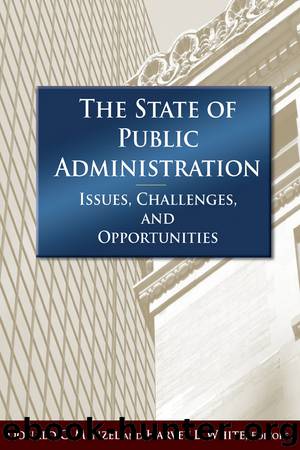The State of Public Administration by Menzel Donald C White Jay D

Author:Menzel, Donald C, White, Jay D
Language: eng
Format: epub
ISBN: 9781317454458
Publisher: Taylor and Francis
FROM GOVERNMENT TO GOVERNANCE: INSTITUTIONAL REFORMS FOR CIVIC ENGAGEMENT
A sea change in approaches to civic engagement emerged about twenty years ago and launched what remains the major innovation through institutional reform at the local level. The numerous new techniques of deliberation and collaboration since that time may be seen as providing support in its development and implementation. Toward the end of the 1980s, one began to hear an occasional voice that referred to governance as differentiated from government. Among the earliest of those voices was that of Harlan Cleveland, who argued that what we need more of is governance, not government (Cleveland 1988). Within the United States and in the international arena, this distinction was articulated with increasing clarity, arguing that the process of governing should no longer be understood as the sole business of government but as involving the interaction of government, business, and the nonprofit (or nongovernmental) sectors. The term collaborative governance is now one of the prominent topics in the public administration literature.6
Reflecting the governance approach, during these years new experiments in institutional innovation began to occur here and there across the nation between cities and their neighborhoods. The power of focusing on institutional design, clearly demonstrated by the Progressive reformers, was being redirected into the hands of citizens rather than operating exclusively under the control of professional experts (Cooper 1984). Officially recognized neighborhood council organizations emerged during the late 1980s and early 1990s in places such as Portland, Oregon; Minneapolis and St. Paul, Minnesota; Dayton, Ohio; and Birmingham, Alabama. This general approach to institutional innovation was first articulated in Milton Kotler’s (1969) Neighborhood Government: The Local Foundations of Political Life. In that work, Kotier called for the creation of legal jurisdictions at the neighborhood level that would function as units of government with certain specified authority and powers. Prompted by the current interest in similar approaches to reconnecting citizens with governance in a more formal manner, Kotler’s book was reissued in 2005 (see Cooper 2005).
Berry, Portney, and Thomson’s (1993) The Rebirth of Urban Democracy documents and evaluates some of these innovative governance experiments in a piece of exemplary social science research carried out over several years. The authors studied five cities that have neighborhood council systems: Portland, Oregon; Dayton, Ohio; St. Paul, Minnesota; Birmingham, Alabama; and San Antonio, Texas. These were matched with ten control cities (two cities each) that did not have neighborhood council systems. Data were gathered on all of these cities using multiple rounds of surveys, interviews, and observation. The key measurement tool employed for comparison was an “index of community participation” (ICP), which the authors constructed from five indicators of participation.
Rebirth reports extraordinarily rich findings from Berry, Portney, and Thomson’s thorough and systematic research. They note that much of the research on citizen participation in governance has had a pessimistic tone that generally blames citizens for not really being interested in participation and denigrates their potential contributions. Berry and coauthors suggest that “social scientists have largely given up on participatory democracy” (212).
Download
This site does not store any files on its server. We only index and link to content provided by other sites. Please contact the content providers to delete copyright contents if any and email us, we'll remove relevant links or contents immediately.
| Anthropology | Archaeology |
| Philosophy | Politics & Government |
| Social Sciences | Sociology |
| Women's Studies |
The Secret History by Donna Tartt(18743)
The Social Justice Warrior Handbook by Lisa De Pasquale(12080)
Thirteen Reasons Why by Jay Asher(8736)
This Is How You Lose Her by Junot Diaz(6700)
Weapons of Math Destruction by Cathy O'Neil(6084)
Zero to One by Peter Thiel(5637)
Beartown by Fredrik Backman(5545)
The Myth of the Strong Leader by Archie Brown(5374)
The Fire Next Time by James Baldwin(5199)
How Democracies Die by Steven Levitsky & Daniel Ziblatt(5096)
Promise Me, Dad by Joe Biden(5036)
Stone's Rules by Roger Stone(4989)
100 Deadly Skills by Clint Emerson(4798)
A Higher Loyalty: Truth, Lies, and Leadership by James Comey(4796)
Rise and Kill First by Ronen Bergman(4658)
Secrecy World by Jake Bernstein(4593)
The David Icke Guide to the Global Conspiracy (and how to end it) by David Icke(4557)
The Farm by Tom Rob Smith(4404)
The Doomsday Machine by Daniel Ellsberg(4375)
